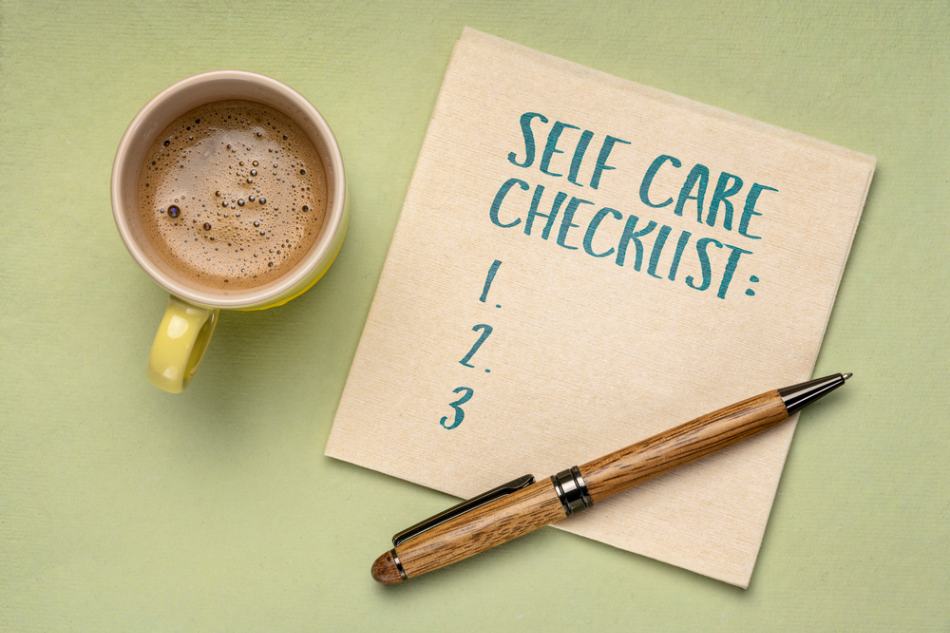January 13, 2022
Webinar: Combining Self-Love and Goal Setting: Living a Values-Based Life
Written by Rachel Eddins
Posted in Self Help / Personal Development, Webinars and with tags: Goals, Values, self-compassion

In this webinar, learn all about self-love, self-compassion, values, and goal setting. Alexis teaches tips for greater self-compassion, including:
- Mindfulness – be in the here and now
- Be curious
- Utilize practice strategies
- Affirmations
- Meditation
- Hand over heart, willing hands
- Journaling
Facilitated by Alexis Leeper, LCSW
Watch a replay of this presentation here.
Learn more about our self-esteem therapy services.
Here is a transcription of the webinar:
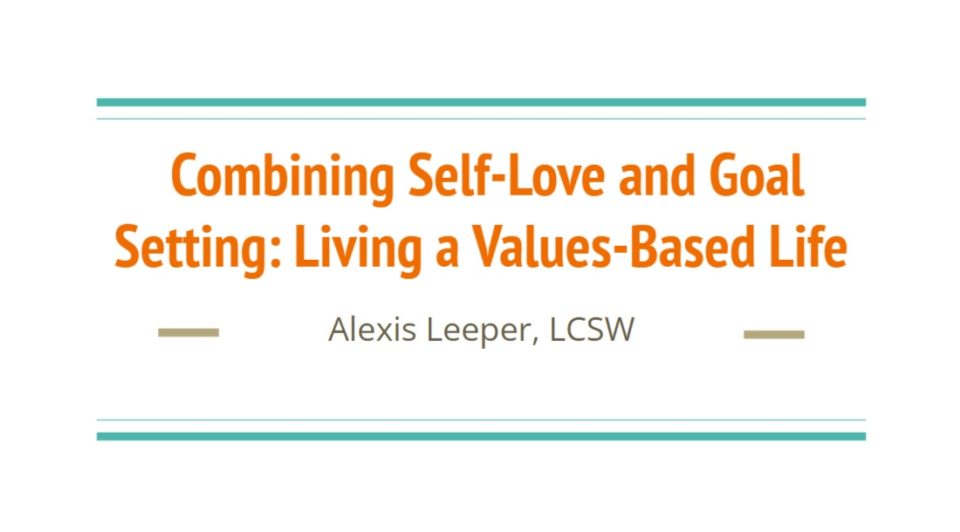
Hello, my name is Alexis and I am a licensed clinical social worker here at Eddins Counseling. I’m really excited to start off the new year with a presentation focused on setting goals.
I think with the new year, obviously, that’s something that everybody can get pretty excited about.
And I’m sure that’s something that you guys are kind of already seeing, maybe on your social media feeds or hearing about in the office or over Zoom (however you are working right now).
Tips for Self-Compassion
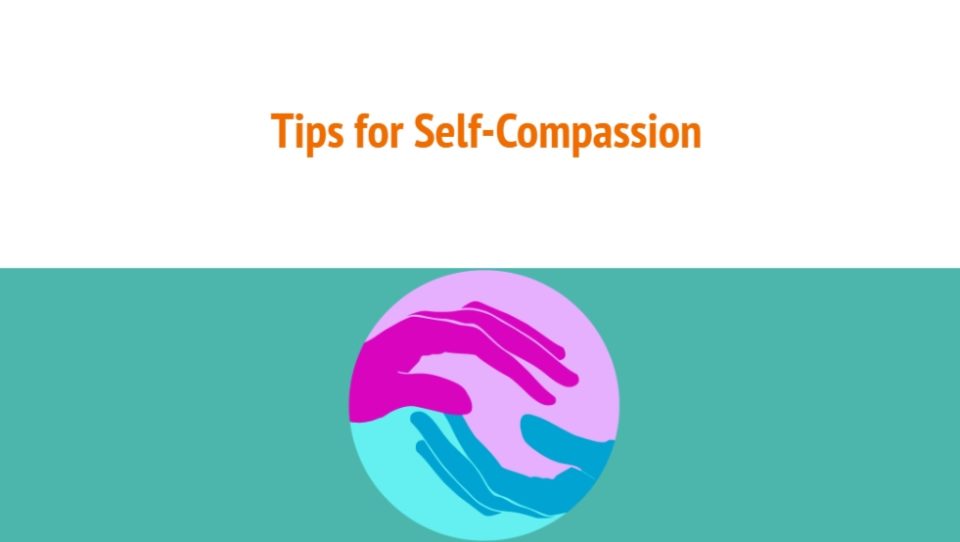
I’m really excited to kind of jump into this topic and we’ll go ahead and just jump right in.
First and foremost, I think it’s really important to start off with a shared definition of some of these concepts that we’re going to talk about.
So we’re going to talk about self-compassion and values. I want to make sure that we’re kind of working off of a shared definition of those things and kind of what that can look like.
So obviously, this won’t be like an exhaustive focus on self-compassion but I did just want to kind of jump in and share some tips that can be helpful for cultivating your practice of self-compassion.
This is something that can be really challenging, especially in the day and age today.
It’s really important to make sure that no matter what we’re doing, especially when we’re confronted with goal setting and potential setbacks or barriers to reaching goals, it’s also really important to have compassion for ourselves.
Self-Compassion Tips
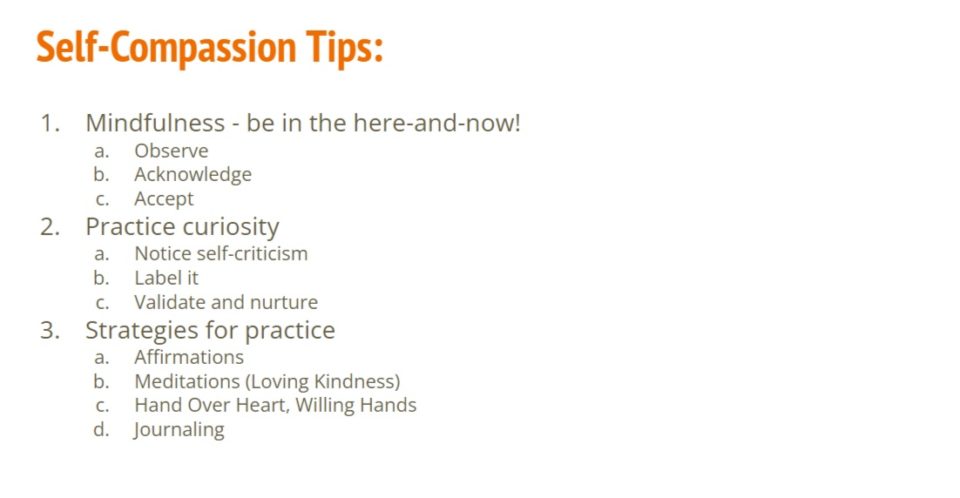
Here are some strategies for jumping into compassion work.
Mindfulness
So first and foremost, we really want to focus on being mindful. So what does that mean?
That means to be in the here and now. My mind is not taking me to anxiety about the future. It’s not taking me to things about the past and I’m not ruminating, I’m connected.
I feel like I can be here with the people that I’m around in my environment, and be fully present and connected.
1. Observe
Mindfulness can be broken down into a couple of different strategies. So first and foremost, I think it’s really important to just observe. In our fast-paced society, it could be really hard to just stop and take a second and check in with ourselves.
One of the first components to cultivating mindfulness and eventually self-compassion is observing our experience.
And so that might be:
- “Hey, what are my thoughts right now?
- What emotions am I tackling?
- What am I noticing in my body”.
I think a lot of times it can be very easy to go: “Well, I’m thinking this, and I’m feeling this”.
But sometimes we forget to think about what is our body telling us. Something that can be important is kind of framing thoughts like: “Okay, what do I want to observe? Well, I want to observe what’s going on internally inside me.”
- What are my thoughts,
- what are my emotions,
- what is my body trying to communicate to me?
And also my environment.
- What’s going on in my environment that I might be interacting with?
- How might that be impacting my internal experience?
2. Acknowledge
Next, we want to just acknowledge and that means acknowledging what’s there part of that observation practice can sometimes come with some judgment. Like if I’m noticing: “Maybe I’m feeling anxious. Well, I don’t like that.”
But before we get to that point of saying: “I don’t like that feeling” and deciding what to do with it, I think most importantly, it’s just acknowledging: “I’m feeling some anxiety.” And it may be a positive emotion and so certainly there may be less resistance.
If what we’re noticing is: “Oh, I feel calm”, then I think naturally we may not push back against that. But certainly, when we’re experiencing those more difficult emotions such as sadness, loneliness, anxiety, and stress, those things can kind of come with that second wave of judgment or criticism. Something to take note of is to label it.
We don’t have to assign meaning to it just yet. Certainly, our brains and our bodies may want to do that, but we can always stop that process when we notice it’s happening and just say: “What are the facts?” Well, the facts are that I’m noticing things like: “I maybe feel anxious. What is my body telling me? Well, when I feel anxious, I know that my heart rate increases. Maybe I feel a little sweaty, maybe I start to feel a little scatterbrained”. And those are just things that I can notice without necessarily assigning criticism or judgment or any deeper meaning to that just yet.
3. Accept
The next step after you have observed and acknowledged what’s there is accepting it. This means noticing that there may be some resistance, and some kind of judgment around: “I shouldn’t feel this way, or maybe I should feel another way”. But we don’t necessarily have to take it that far. We can always say:
“Hey, I’m noticing that something’s going on. I’m going to try to name it and label it, acknowledge what’s there. And then just accept like, this is where I’m at right now.”
4. Practice Curiosity
One way to kind of help cultivate that is to practice curiosity.
5. Notice Self-Criticism
As I’ve kind of mentioned, it’s very easy for self-criticism or self-judgment to sneak in. A way to soften some of that might be approaching with curiosity.
Oftentimes when we experience emotions that are difficult, it can be almost automatic to start judging ourselves for having these emotions or questioning:
- What’s going on?
- What’s wrong with me?
- Why am I feeling this way?
To some degree, that curiosity is needed but we can also soften that in some ways to say:
- “I wonder, what is this emotion or what is this sensation or what is this thought trying to tell me?
- Where did it come from?”
6. Label Emotions
This leads to practicing labeling. And taking it a step further to even try to validate ourselves or to nurture ourselves at that moment.
To build off that example: “If I’m feeling anxious, maybe I can kind of check in with myself and see if there is anything that maybe caused me to experience that anxiety? Was that something inside me? Was that something external? What was going on there?”
Then if I say: “Okay, maybe it happened from something external, and maybe, for example, I’ve got a lot on my plate at work right now, and I’ve got some big deadlines coming up”.
And so to validate that, we could say: “Well, I can understand why I feel anxious because I’ve got a lot on my plate right now. Anyone in this position would probably feel anxious.” That’s a natural response to having a lot going on.
7. Validate and nurture
That’s potentially how we can kind of practice validating that experience and then also kind of cultivating some nurturance by potentially even saying: “What do I need at this moment? How can I validate and also offer myself some support? What do I feel like I need at this moment?”
Well, when I’m feeling anxious, maybe what I need is to step away for 15 minutes, focus on my breathing, focus on grounding myself in my environment, and what’s going on around me, to further listen to and honor these messages that our sensations or our thoughts or our emotions themselves might be trying to tell us.”
Strategies for Practicing Self Compassion
Some of these strategies can be difficult and they may not necessarily come naturally.
Affirmations
Some strategies for cultivating self-compassion could be, for example, affirmations. So affirmations are positive statements that we can utilize to help us to stay motivated, help in difficult times, and have negative emotions. So an example of a mantra might sound like this: “I’m secure, I can handle difficult moments. I can handle difficult emotions”.
That extra boat of confidence in those moments where maybe we’re struggling or we’re not necessarily able to immediately identify with our capacity to handle something.
Meditation
One strategy to cultivate self-compassion is meditation. So, for example, Loving Kindness meditation can be helpful for cultivating self-compassion which looks like this basically: “How can I send compassion to myself, to people that I care about, to people maybe that I don’t like, to people that I don’t know?” It includes ways that we can mentally practice giving compassion to others.
It can be helpful for allowing us to access that for ourselves. A lot of times when I work with clients, they tell me they have compassion for other people. It’s when they try to have compassion for themselves, that they start to struggle.
Utilizing something like loving kindness as a meditative practice can be helpful because it kind of helps us practice a little bit on how we play around with our compassion. First, it can be really easy to access the compassion that we have for people that we care about, our loved ones. It might be a little bit more of a challenge to access compassion for people that we maybe don’t know or even people that we don’t like. But by practicing that flexibility, it allows us then to also come in and practice providing that for ourselves.
Hand Over Heart, Willing Hands
Some additional strategies are hand over the heart. This can be helpful for providing a tactile anchor. And just means that when you’re noticing resistance in yourself or that openness within our nervous system, it’s openness in general.
Journaling
And then finally, strategies for practice might be journaling. So, this means working through:
- What are those things that I’m noticing when I’m observing?
- What can I acknowledge?
- And what can I accept?
- What maybe gets in the way of that acceptance?”
In general, these are just kind of strategies, and tips for cultivating self-compassion, which ultimately will allow us to meet ourselves with compassion in those moments when maybe we’re struggling to really maintain or fully meet the goals that we’ve set out.
Test Your Self-Compassion, Dr. Kristin Neff
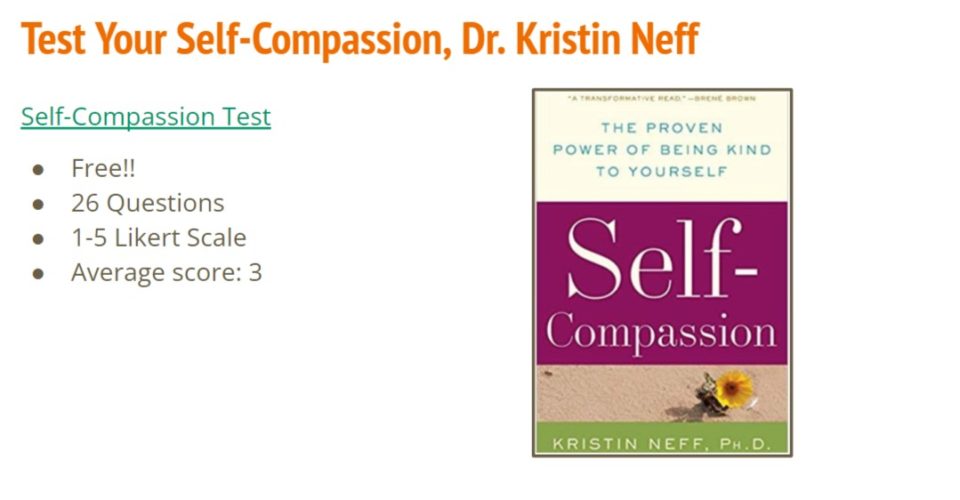
A fun little self-compassion exercise is this really cool Self Compassion test that was put together by Dr. Kristin Neff. She does a lot of work pertaining to self-compassion.
I really like this test because number one- it’s free, so nothing wrong with a good free resource, and it’s pretty quick. It’s only 26 questions, and they’re basically all designed on a 1-5 Likert Scale. Based on this experience, where do you feel like you fall: strongly disagree, this doesn’t describe me, doesn’t fit with me too strongly, or agree- this sounds exactly like me.
In general, it can give you a score to help you figure out where is your compassion level.
Scores are typically an average, about a three, but they range from one to five. That might be a strategy for checking in with yourself:
- Where am I in my level of self-compassion?
- How can I start to cultivate and lean into that practice, which ultimately can be helpful for helping me reach my goals?
Values

Let’s also talk about values. In general, values are simply just like it says, just our standards, our principles of guiding our behavior. It can be a really helpful judgment for what we determine is most important in our lives.
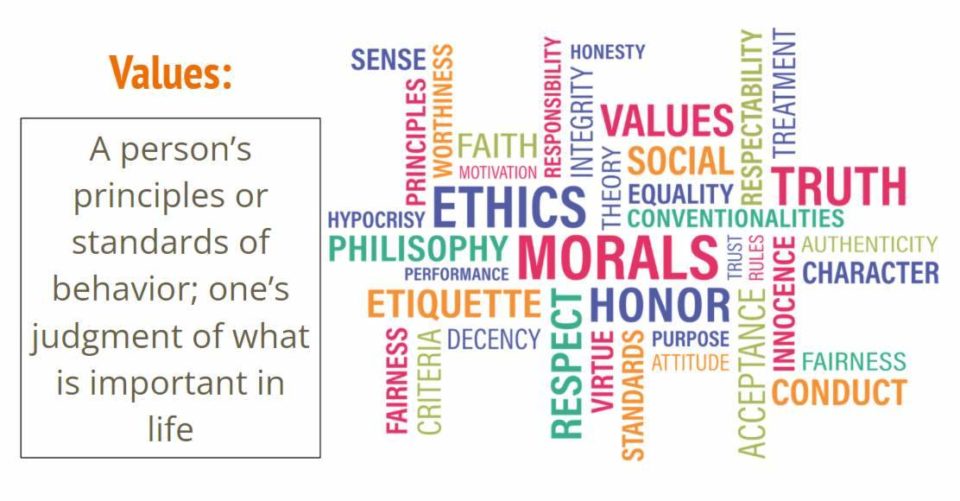
Essentially, when we talk about values, we’re talking about what is important to us in our hearts, our minds, and our souls. What is it that helps us feel connected, helps us feel alive, helps us feel like we are living in a way that makes an impact and is meaningful?
Values Exploration: Questions to Consider
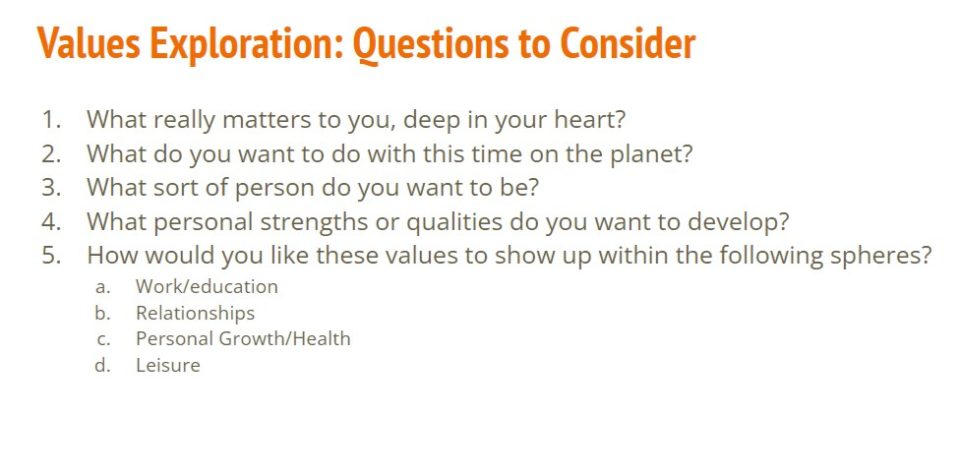
Some general questions to consider when you’re starting to explore and identify your values might be:
- What really matters to me?
- What do I want to do with the time that I have on this planet?
- What kind of person do I want to be?
- How do I want people to perceive me?
- How do I want to be remembered?
- What strengths do I bring to the table?
- What qualities do I want to develop and cultivate to live a more authentic life?
- How do you want your values to really show up in your life?
Certainly, values are going to shift based on where we’re at in the context of what we’re doing so we need to think about how our values shift and how we want them to show up in our place of work, our career, and our education. How about in our personal lives, our relationships, our families, our friends, and our romantic relationships? How do we want this to show up in our health-related goals or our goals related to personal growth? Finally, of course, leisure. How do we want our values to show up in those times of leisure, fun, and adventure? What do we want those things to look like?
Something that’s important to note here is that our values are going to shift depending on what domain we’re looking at.
Some values may show up in one domain and not another one versus other values may show up in all of the domains because depending on the values that you have, they may have a place in every domain.
Strategies for Values Exploration
YOUR VALUES: What really matters to you deep in your heart? What do you want to do with your time on this planet? And what sort of person do you want to be? What personal strengths or qualities do you want to develop?
- Work/Education: Includes workplace, career, education, skills development, etc.
- Relationships: Includes your partner, children, parents, relatives, friends, co-workers, and other social contacts.
- Personal Growth/Health: may include religion, spirituality, creativity, life skills, meditation, yoga, nature, exercise, nutrition, and/or addressing health risk factors like smoking, alcohol, drugs or overeating, etc.
- Leisure: how you play, relax, stimulate, or enjoy yourself: activities for rest, recreation, fun, and creativity.
THE BULL’S EYE:
make an X in each area of the dartboard, to represent where you stand today.
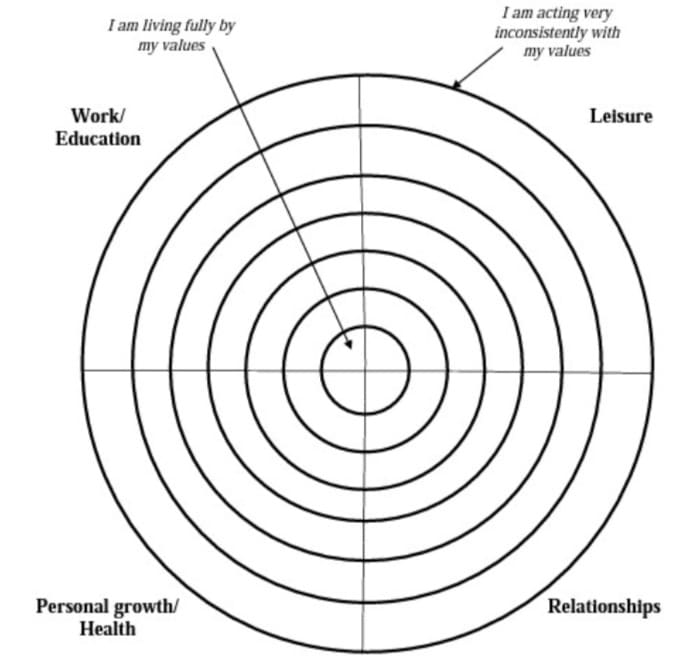
I’m going to switch over to some strategies for exploration. We will be starting off with the valuables and utilizing these types of questions that I discussed. Something like this worksheet can be helpful to identify these domains: work relationships, personal growth, and leisure. Where am I currently living my values? So when we look at the bullseye here in the middle, that means we’re living a life that’s fully in line with our values versus on the outskirts. Maybe we’re living a life that’s more inconsistent with our values.
It’s important to reflect, once we identify our values, how in line do we feel like these are with these different domains in our lives? And so in some places, we may be doing better than others. Maybe my values to personal growth and health are more aligned than what I’m able to do in my work or in school, depending on what context that is.
Next, in general, it could be helpful to kind of break down these domains even further. Obviously, within the context of family, if I’m a parent, my values are going to be different with being with my role in parenting than they might be in my role as a spouse. Further breaking down these different types of domains in our life can also help us to narrow down our values a little bit more. And so something like this can kind of allow us to say: “Okay, within these more nuanced, more detailed domains in my life, how do I want values to show up?”
Values Exploration: The Life Compass
In the main part of each large box, write a few keywords about what is important or meaningful to you in this domain of life:
- What sort of person do you want to be?
- What sort of personal strength and qualities do you want to cultivate?
- And what do you want to stand for?
- What do you want to do?
- How do you ideally want to behave? (If a box seems irrelevant to you, that’s okay: just leave it blank. If you get stuck on a box, then skip it, and come back to it later. And it’s okay if the same words appear in several or all boxes: this helps you identify core values that cut through many domains of life.)
Once you’ve done that for all boxes, go through them, and in the upper small square inside each box, mark on a scale of 0-10 how important these values are to you, at this point in your life: 0= no importance, 10=extremely important. (It’s okay if several squares all have the same score.)
Finally, in the lower small square inside each box, mark on a scale of 0-10 how effectively you are living by these values right now. 0=not at all, 10=living by them fully (Again, it’s okay if several squares all have the same score.)
Finally, have a good look at what you’ve written. What does this tell you about:
- What is important in your life?
- What you are currently neglecting?

Again, what we value in our community and in our environment may be totally different than what we’re valuing in our personal growth or our leisure spaces.
Breaking these things down and going into the details and the nitty-gritty of it all allows us an opportunity to figure out where these values fit. Something that can also be helpful is identifying then how important these goals are. And so we can use things like ranking systems, zero to ten scales to say: “Right now, I’m not living a life in this domain that is in line with these values, but how important is it to me that I start to do that?” And naturally, that can influence the kind of goals that we set.
Since we’re talking about values a lot, it’s important to start exploring what are our values. So this is a core values list.
This looks at your core values in each domain of your life. I really like this one because in my values work, it’s very easy to become overwhelmed with the amount of values. Theoretically, there could be hundreds and hundreds of values and I like this one because I think it does a good job of giving a wide variety of values.
Essentially what I like to recommend is taking about five minutes maximum, running through the list, and just checking very quickly, not allowing yourself to overthink too much:
What are values that stand out to me?
For example, when we skim the list, examples of various boundaries are listed. Obviously, there are quite a few, which is why I recommend trying to be quick about it, so don’t allow yourself to start second guessing or overthinking too much very quickly. Just think: “Is this something that I value? Yes or no? If it’s yes, I’m going to give it a checkmark, and then I’m going to move on.” It is a lengthy list of values, as I said, I think there are about 50 on here.
A good starting point is first identifying out of the 50, which ones maybe speak to you or which ones are values that you feel are in line with either the life that you’re currently living.
I think it’s also helpful to also add what are the values that maybe aren’t showing up in your life right now but that you want to show up. I always let my clients just identify what is presently available and what they might want to also be available, even if that’s not currently happening. From here, what I typically recommend is, for example, let’s say a lot of times I’ll have clients that come back and they say: “Oh, I’ve got like 20 or 30 values off of this 50 value list.” And so from that what we look at is how can we start grouping values by the overarching kind of theme and so that can be one strategy to kind of help narrow down your list.
But then also, as I mentioned before, the ranking system of how important is this value to you on a zero to ten scale? And so kind of recognizing: “All right, there are values that are going to stand out as most important, and they’re going to be values that will eventually come to be maybe least important”.
Values that are in that most important category are going to be the ones that we’re going to prioritize.
Typically, I recommend about ten. Once we get past ten, it can feel a little overwhelming sometimes. And so you want to try to get it down to ten, but it doesn’t actually have to be ten, it can be as close to that as you can get it. And again, these are just going to be helpful to overarchingly inform what our goals are. A lot of times, if we’re able to connect our values to our goals, we’re going to have more buy-in, we’re going to have more motivation because if we want to live a life in line with our values, like most of us do, that’s going to help really drive home the point of why we’re setting the goals that we’re setting.
Tips for Goal Setting

Let’s get into goal setting.
Setting Goals
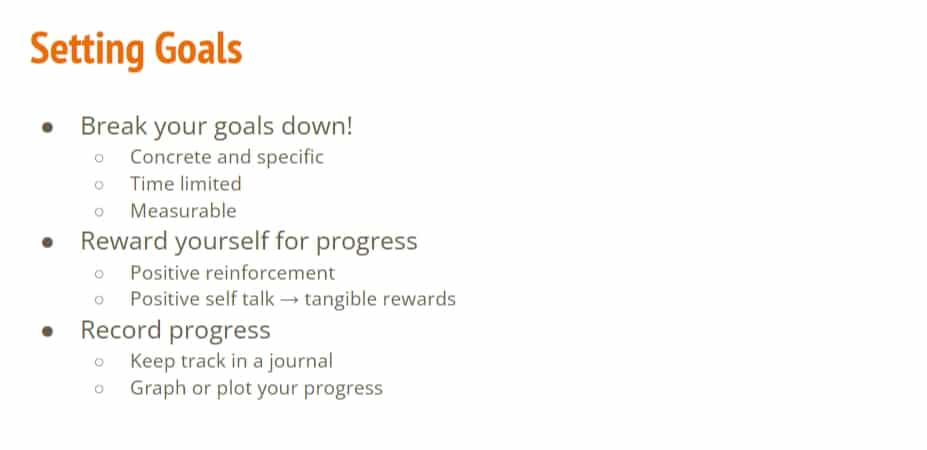
Break Your Goals Down
First and foremost, some general strategies for goal setting are going to be that we want to be able to break our goals down into very concrete, specific, time-limited, and measurable goals.
So, if I have an overarching goal of “I want to be a better friend”, but I don’t go into any more detail than that, I don’t really know what that looks like. And so if I’m not defining that and getting into the specifics of what that looks like, then I don’t have a good foundation of setting a goal that I can actually come back and say: “Okay, I took these steps to reach this goal”.
We want to make sure, again, that we’re specific, concrete, very clear, and time-limited in how we’re setting our goals, but also to make sure that we give ourselves a point of measurement where I can look back and say: “Okay, I know that I needed to do this X amount of times and so if I set that from the outset, then I can come back and say, well, did I do that? Yes or no?” And that can be helpful for kind of measuring our progress.
Reward Yourself for Progress
Additionally, we definitely want to reward ourselves for the progress that we do make. Sometimes it can feel like maybe we’re making baby steps. But ultimately, those baby steps are going to lead to larger steps that will get us to our long-term goals. Ways that we can do this is through positive reinforcement and that can range from anything like positive self-talk (“Hey, I’m really proud of myself today because I did XYZ, and that’s working towards my goal”) or two, an actual tangible reward. There’s nothing wrong with giving yourself a little treat every now and then when you’re working towards something really hard.
Record Progress
And then finally, we definitely want to record our progress. It can be helpful to try to keep track of things or even create our own Excel spreadsheet because then we can get actual data with graphs, plots, and charts to look at and see: “Hey, what is my progress? As long as we have made sure that those goals that we’ve set are measurable, we shouldn’t have any problem monitoring our progress.
Values and Setting Goals
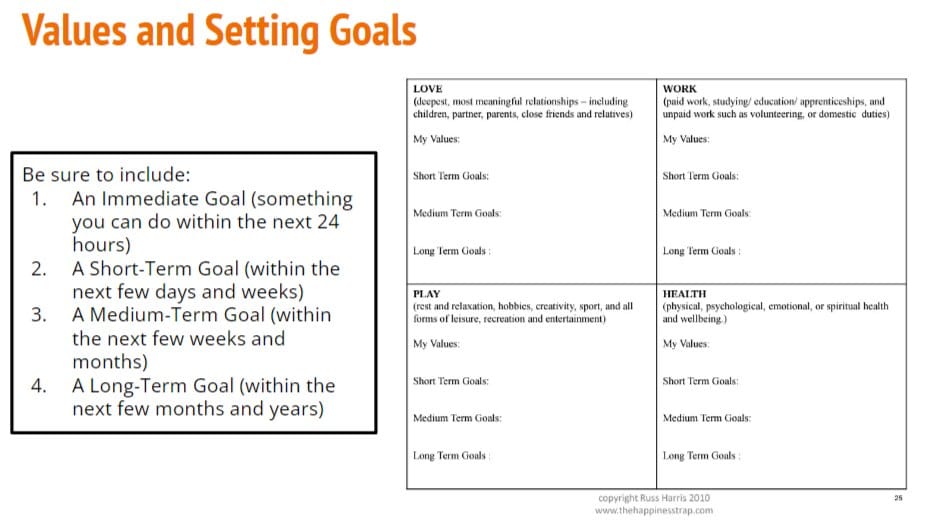
Let’s go into some more specifics around. How do we set those time-limited specific goals? What I like to recommend is a couple of different strategies for breaking that down. We want to include, first and foremost, what is our value that we’re trying to connect to our goal, and then what is our overarching goal.
Immediate Goals
I have an example that will go over, but for now, I’ll kind of keep it general. So first and foremost, one of the most helpful things that we can do for ourselves is to set an immediate goal. What is one thing that I can do in the next 24 hours that will ultimately help me take a step towards whatever my goal is?
Short-Term Goals
Next, we want to set short-term goals. So in the next few days to the next week, what is another step that I can take that will ultimately help me move closer to reaching my goal?
Medium-Term Goals
Next, we can break it down even further to the medium-term goal. This might be in the next few weeks, the next month, what do you want to have accomplished? What do you want to work on accomplishing?
Long-Term Goals
Then finally and this is probably something that will be reflected in your kind of overarching goal. What is your long-term goal? In six months, in a year, in two years, what is the goal that you are working towards?
Breaking them down into these smaller chunks can be helpful not only in helping us figure out what are the steps you need to take in the long term to reach these overarching goals, but what steps you can actually take right now to start working towards your goal.
Combining It All Together
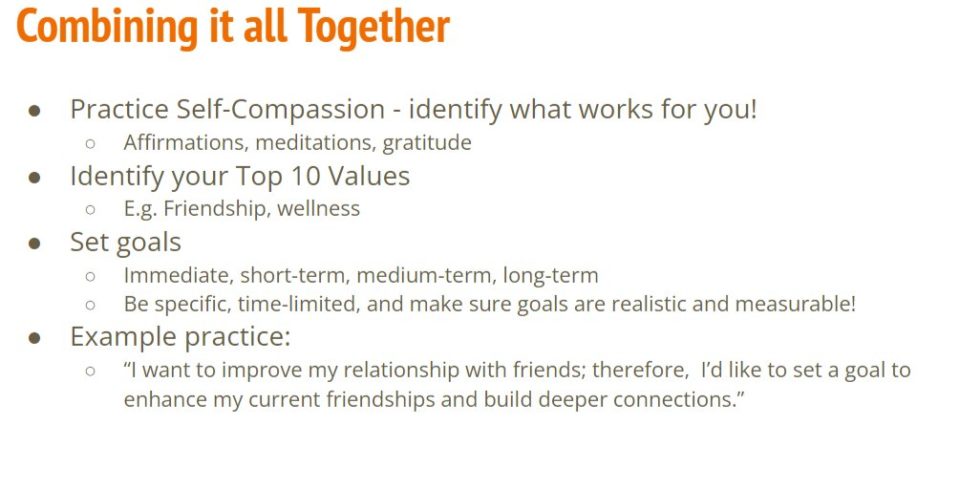
Let’s talk about how to combine everything together.
Practice Self-Compassion
So first and foremost, self-compassion is a skill. It’s not something we immediately know how to do. It’s something that we have to learn to do, and it’s something we have to cultivate and practice and it takes consistency. A big piece of that is identifying what works for me.
For some people, that might be affirmations, gratitude, journaling, or meditation. Ultimately, no coping skill is one-size-fits-all and there is some nuance and some obvious uniqueness to all of us.
It’s really important to figure out what works for you. That may take some experimentation, that may take some trying out some goals that are trying out some skills that maybe don’t feel like they work. And some trial and error, some troubleshooting around some of that. But ultimately, we can all find a combination of strategies and skills that help us reach success. I think it’s just about being open and being willing to try new things, even if it means that that may not be the skill for us.
Identify Your Top Ten Values
Additionally, identify your top ten values. So examples of that might be friendship or wellness-based goals. Those are going to be examples that I’m going to circle back to here shortly.
Set Goals
We want to set our actual goals. Based on these values that we’ve identified, what are the goals we want to work towards? And we want to make sure, again, that those are specific, time-limited, realistic, and measurable. We want to make sure that we’re kind of identifying goals to help track our progress along the way.
What can I do immediately versus what is the overarching, long-term goal that I’m working towards?
Example Practice
Let’s talk about an example. So let’s say I’ve identified friendship as one of my top ten values. A goal that I have that’s based on the value of friendship is “I want to improve my relationships with my friends, so I’d like to set a goal to enhance my current friendships and build deeper connections with those people”.
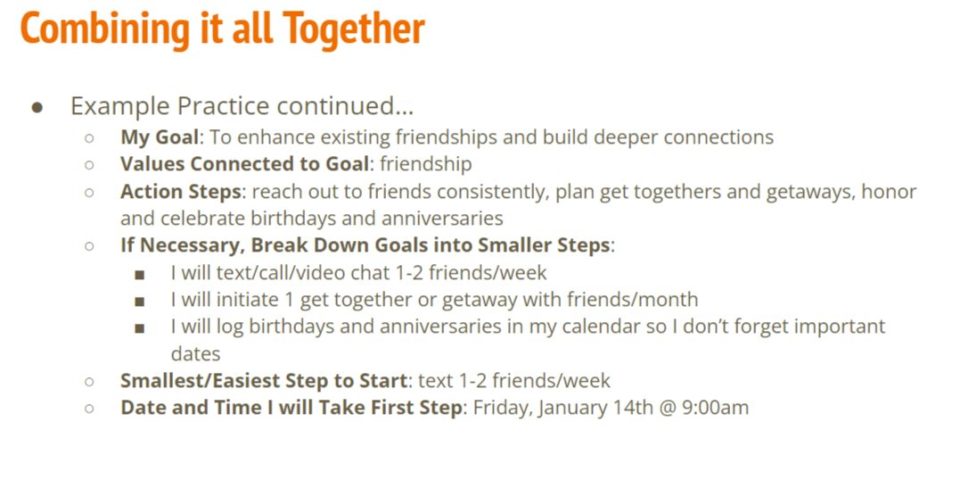
So let’s break that down a little bit to look at what that looks like in action, utilizing some of these strategies. Something that can be helpful for kind of setting it up.
My Goal
First and foremost, identifying the goal. So my goal here is I want to enhance my friendships and I want to build deeper connections with my friends.
Values Connected to Goal
What value is connected to that? Well, obviously, friendship. But we could kind of take that even broader and say, maybe it’s relationships or maybe it’s connection. Maybe I just want to feel connected to people.
Action Steps
So what are the action steps? What are things that I want to start doing actual behaviors that I can utilize as a form of measuring my progress?
Break Down Goals Into Smaller Steps
Examples of that might be: “Okay, I want to reach out to my friends consistently. I want to plan get-togethers, I want to plan getaways, and I want to celebrate their anniversaries and their birthdays, and I want to be there for them for those big life events.” So we may want to take that a step further and say: “Well, how can I break that down into even smaller steps?”
This is where we’re going to get more specific: “I want to text call or video chat my friend one to two times a week.” We want to make sure that that doesn’t feel overwhelming. But what I can say is: “Yeah, I can shoot my friend to text once a week. That feels manageable. I could probably do that.” And I’m getting quantitative numbers assigned to this, which will ultimately help me track my progress later on so I can look back and reflect and say: “Well, did I text, call or video chat my friend once a week? Yeah. Okay, well, then I’m making progress. No, I didn’t. Okay. Maybe I need to reevaluate that goal. Maybe that wasn’t realistic for me.”
I think there’s an element of troubleshooting. We can set our goals with the best intentions, but we may have to come back and reevaluate.
Because we can’t predict what we’re going to be going through or what life is going to throw at us and sometimes that means maybe we step back and reevaluate things that weren’t realistic for us.
But to continue kind of breaking that down, I want to initiate one get-together or one getaway with my friends once a month. Again, that may be kind of a lofty goal. That may prove to be an unrealistic goal. But ultimately, I’m going to throw something out there, and I’m going to try to get it as quantitative, specific, and measurable as I can.
Next, I want to log birthdays and anniversaries in my calendar so that I don’t forget these important dates. Obviously, we all live pretty busy lives and we may not remember all these things. But again, one step that I could break down into a smaller step is to say: “Well, maybe I just go through my calendar.” Luckily, we have Facebook now which reminds us of everybody’s birthdays. But I could go through my calendar and just say: “Here are all these birthdays”. So I remember these things.
Smallest/Easiest Steps to Start
So let’s start then with the smallest or the easiest step. The smallest step here is I’m going to text one to two friends a week. And so I want to then be very specific.
Date and Time I Will Take The First Step
When do I want to start doing that? Let’s say I set this goal up today. So, tomorrow, Friday at 09:00 a.m., I’m going to text one friend and check in, see how their Friday is going. There are no necessary rules around what I have to say. I mean, it could just be a simple text: “Hey, I was thinking about you. How’s your week going?” But ultimately, that’s something that we specifically determined that I can do and I have a timeline for when I want to try to get that done.
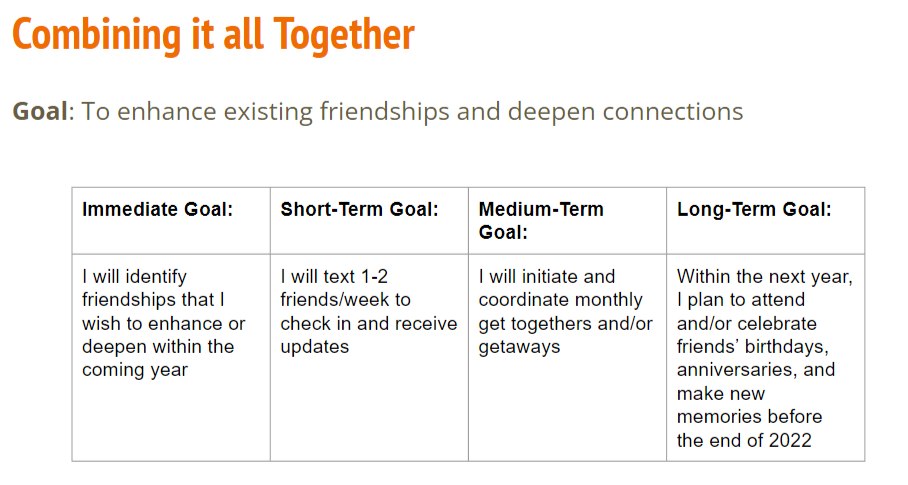
So let’s apply the greater content here. Reiterating my goal to enhance the existing friendships to deepen my connections with the people that I’m friends with.
Immediate Goal
My immediate goal is: what are the friendships? I want to identify these friendships that I want to enhance. Who are the friends in my life that I maybe feel like I’ve fallen out of connection with, or I haven’t talked to people who I want to be texting? But maybe an immediate goal here is to figure out who are those people, who are those friends.
Short-Term Goal
Then, the short-term goal is “What are we going to do in the next few days or so?”. Well, in the next few days to a week, I’m going to meet this goal of texting at least one friend a week just to get some updates and see how they’re doing.
Medium-Term Goal
My medium-term goal (weeks to a month), again, I want to initiate and try to coordinate some monthly get-togethers and or even some getaways. On a monthly basis, I’m going to try to coordinate what I can.
Long-Term Goal
Then generally, the long-term goal. So within the next year, I plan to attend and/or celebrate friends, birthdays, anniversaries important events, and make new memories with these friends before the end of the year.
These are all strategies that are specific, time-limited, and measurable. Throughout the time, I can check back in with myself and say: “Hey, am I reaching these goals that I set?”
So let’s try to continue with some examples. I know we went through the value pretty quickly, and I’m happy to pull that up if you guys feel like it would be helpful. But I’m wondering if there were values that maybe stuck out to somebody or we could even potentially start with some goals instead and apply this formula, maybe with an example that maybe somebody in the Zoom is working on, anybody willing to share anything? Are there any goals that they might be trying to reach or any values that they want to utilize as a form of goal setting?
Q and A
I went ahead and compressed all of the documents that I just presented, and I went ahead and sent that over in the chat. So let me know if you guys have any issues accessing that information. But hopefully, that will make it a little easier to be able to see the values list. I know that the handouts, they’re a little blurry, so I definitely understand. So let’s work on another example while you guys are perusing those documents. And again, let me know if you have any issues accessing them.
Goal Setting: Wellness
So let’s look at a value like wellness. Obviously, I think that’s one that most people are probably very familiar with in terms of goal setting around wellness and health goals, especially around the New Year. Let’s again apply the same formula here.
Let’s say that the overarching value that I’m wanting to address is wellness. So I really want to focus on my health and my wellness. I want to feel better about those goals this year and how I can grow in that area. Let’s say the goal is I want to build my strength. If my overarching goal is: “Okay, I want to build my strength.”
Immediate Goal
Let’s look at immediate goals that I can utilize with this overarching goal of building strength. Right now I’d say I could probably do about five push-ups. So my immediate goal or my overarching goal is I want to build strength and so a way that I want to build strength is to increase my endurance by doing more pushups. I know right now five is about all I’m going to get. My immediate goal here is something that I can do in the next 24 hours.
Well, what I can do in the next 24 hours is maybe focus on upper body strength. And so I’m going to identify workout plans. That plan may include doing three upper body exercises three times a week, and I’m going to apply that plan. My immediate goal is to identify my workout plan. What do I want that to be? Let’s say I want to pick three exercises to help build my upper body strength, so I’m going to do push-ups, bicep curls, and dips. The immediate goal in the next 24 hours: I want to identify my workout plan.
Short-Term Goal
In the short term, how do I want that to show up in the next few days to the next week? Well, I know the three exercises that I’m going to do, and so I want to dedicate myself three days a week that I’m going to do those exercises. The short-term goal is: in the next few days in the next week, I’m going to shoot for three exercise sets out of the week.
Medium-Term Goal
My medium-term goal, then, is what I want to try to accomplish in the next three to four weeks, or the next month. So in the next month, I want to move up from five push-ups to ten push-ups, utilizing three workouts a week. By the time that I have been doing this for theoretically three to four weeks consistently, I want to make sure that I moved up from being able to do five pushups to being able to do a full ten pushups.
Long-Term Goal
Then generally again, the long-term goal is that I want to build my strength. What does that look like for me? Well, ultimately, if I’m starting off in the very beginning, only being able to do five pushups, maybe what I want to get to is I want to be able to do 50 pushups with ease. Over time, I may need to check in and kind of reevaluate my goal as I’m getting closer to those 50 pushups.
Let’s say I really like to come in gung ho with this. And I stick two, three times a week, I’m doing these three exercises and I realize: “Hey, I can actually do 50 push-ups, and it didn’t take me six months to a year to get there. So let me reevaluate my goal. How might I want to continue building this upper body strength?”
General Values
Let’s look at just kind of general values. So obviously, I know that it’s two full pages. And since you guys are just learning about this material, I can imagine you probably don’t have your top ten goals narrowed down just yet.
But why doesn’t somebody share a value that sticks out to them? Just feel free to type it in the chat, volunteer it, and then let’s strategize some goal setting that we could do pertaining to any values that may really stick out to people.
Service as a Value
Let’s go back to the core values list here. Again, another reason I really like this list is that it gives definitions. Obviously, we probably know what the definitions are, but I think it can be helpful to have that extra structure. So according to the core values list that we’re working off of, service looks like being helpful to others and being of service to others.
Let’s say potentially an overarching goal that we could connect to that is, I want to be a service to people in my community. To some degree we could go out and potentially survey people in the community and feel like and kind of get an idea for what these people need. But we don’t necessarily have to go that far. This can be very individual in terms of I can provide service to my community in whatever way I maybe feel works for me. We could say: “Okay, an overarching goal is that I want to be of service to my community”.
Immediate Goal
So let’s say that the immediate goal could be identifying what something that I see is maybe lacking in my community or what is something that I feel my community needs that maybe we don’t have or something maybe we need more of.
So, for example, I am in the Montrose community and so something that I notice in my community is that a lot of people will not pick up after their dogs. To be of service to my community in a concrete way, and an immediate goal that I can identify is I know that every time I walk my dog and I pick up after them, I feel annoyed when I see that other people didn’t do that. And so my immediate goal is I want to service my community by maybe helping out in that way, I’m already taking up my own dog poop.
Might as well help out the community and do something for everyone to better the environment and increase beauty in the nature around me. My immediate goal is to carry some extra waste bags so that I can assist in picking up additional waste in my community along my walk with my dog.
Short-Term Goal
So short-term in the next few weeks, or the next few days, two weeks, maybe something else that I can do is I know that this is an issue and so every time I take my dog on a walk, I’m going to pick up one or two extra pieces of waste that I see. But also maybe something else that I’d like to do is there are these little containers for basically community waste bags, and so every time I walk by the community waste bag post, I’m going to just stick a little dog waste bag in there for other people in the community.
Looking at these short-term goals, these are very measurable. They’re very concrete. I know that I did it. Because I went on a walk with my dog and I maybe picked up one extra piece of waste and I left the waste bag in the community waste container.
Medium-Term Goal
The medium goal might be something that I can do in the next few months. Maybe something that I feel like I can do in the next few months is starting posting on the next-door app, figure out who my neighbors are, and who are people in the neighborhood that have dogs. And how can maybe we as dog-owning members of the neighborhood, maybe collectively collaboratively get together and figure out how can we solve this problem as a community? So maybe in the next few months, I want to craft a post next door and try to start getting some more dog owners in the community to kind of help out with this effort.
Long-Term Goal
Then let’s look at the long-term goal. So the long-term goal here is I want to not only be doing things individually in my own day-to-day to help out my community in this specific way, but I also want to be trying to engage with other people in my neighborhood, other dog owners, to see what we can do to try to tackle this issue together. And so maybe the long-term goal is: I created and I work towards creating a network of dog owners to collectively take on this neighborhood responsibility. “We’re all going to just pick up one extra piece of waste and we’re all going to just contribute one dog waste bag to the community storage.”
That might be a way that not only am I connecting to my individual responsibility within my community but also getting other people connected and engaging other people and helping everyone to kind of feel empowered and to take accountability and to try to create a better environment that ultimately services the whole community and makes the neighborhood more beautiful.
Be compassionate with yourself
Thank you guys all for coming and for your participation and definitely in your goal-setting journey I highly recommend continuing to be compassionate with yourself and being open to reevaluating your goals. Sometimes we set some pretty lofty goals, and it’s okay to come and check in and say: “Hey, maybe I was shooting for the moon there and maybe I need to shoot a little bit closer to home” and that’s okay.
It can be really helpful to have that compassion for ourselves, but also continue exploring our values and figure out how you want your values to show up in the way that you set goals.
How can you integrate self-compassion along the way so that you feel like: “Hey if I need to make some changes, we can always change and update these goals. But ultimately what’s most important is whether am I taking the steps to reach this overarching long-term goal. That may mean we need to evaluate, we need to reevaluate some short-term or medium-term goal setting.
Ultimately, if it helps us maintain consistency and reach these overarching goals, then it’s definitely worth it to make those changes and to meet ourselves with compassion, because especially now, we can’t always control what life throws at us.
I think even now more than ever, It’s important to be compassionate towards ourselves in the way that we set goals, because it may take some extra time, it may take some reevaluation, it may take some troubleshooting, and may take some experimenting. And ultimately, as long as that helps us to maintain and reach these long-term goals, it’s definitely worth it to kind of be open and willing to re-evaluate.
Thank You
Thank you guys so much, and please feel free to email me or reach out.
If you guys have any questions about any of the documents, please let me or Marcus know if the documents don’t work, and then don’t forget to fill out the feedback survey.
We love to hear your guys’ feedback and again, thank you guys so much for attending and I hope that this was helpful and informative for everybody.
Future Webinars
To see a list of all upcoming wellness webinars, click here.
To view our webinar archive, click here.
To get started with an Eddins Counseling Group therapist in Houston, Montrose, or Sugar Land, call (832) 559-2622 or text (832) 699-5001 us today!
Why You Feel This Way
Get instant access to your free ebook.
Grounding & Self Soothing
Get instant access to your free ebook.
7 Mood-Boosting Tips
Get instant access to your free ebook.

